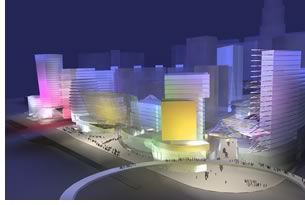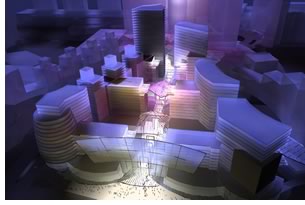

04/2005
New York City’s Ehrenkrantz, Eckstut & Kuhn Architects, is planning and designing a $6 billion, 18-million-square-foot vertical development called the MGM MIRAGE Project CityCenter for MGM MIRAGE Corporation on the Las Vegas Strip. The 66-acre metropolis will be built between the Bellagio and Monte Carlo hotel casinos and will be a mixed-use cosmopolitan center of hotels, luxury condominiums, and shopping—all within an urban setting.
The mixed-use development will be composed of a “skyline” of three 400-room boutique hotels, one 3,000-room hotel and casino, four towers of 2,500 residential units, and 550,000 square feet of high-end retail, dining, and entertainment space. The total number of buildings will be between 40 and 50, with the tallest buildings 65–70 stories. Construction will begin this summer and completion is expected within five years. The modest Boardwalk Hotel, owned by MGM and known for its Coney Island amusement park façade, currently sits with lot space between Bellagio and Monte Carlo but will close in May 2006.
The ambitious mini-city project will allow people to gamble, shop, dine, walk, and even live—without ever leaving the property. The pedestrian-oriented urban environment will be the first on the Strip to combine private residences with hotels and casinos. Public squares, hidden parking structures, covered passageways, and a boulevard are all part of the urban plan.
Integrated work of architecture
Stanton Eckstut, FAIA, principal-in-charge, points out that MGM MIRAGE
is an integrated work of architecture stressing a cosmopolitan design. “MGM
came to us with a vision of a city as the next attraction, believing
that Las Vegas was maturing and needed more of an urban fabric,” he
says. “They were seeking higher density and mixed uses. They
were challenging us to accomplish that.”
Peter Cavaluzzi, FAIA, design principal, explains that MGM had an interest in residential. “It’s a big market that they are trying to meet in Las Vegas, and they wanted to create a development right on the Strip that incorporated residential,” he says. “They had a vision of ‘the city of the 22nd century.’ They wanted it to be very contemporary and a reflection of Las Vegas’ new brand of urbanism. This is not a theme development. The theme, if there is one, is city-making.”
Eckstut stresses that the density of parking was one of the biggest challenges. “Parking is free and there is a lot of parking. We were given the opportunity to provide convenient parking and at the same time, through design, make sure you never see the parking. That’s not something any modern city has done, and the absence of visible parking creates a marketing advantage with the fact that there will be no charge for parking. We also were able to link all the rooftops together to create an upper level park system with a landscape throughout all the rooftops responding to the desert climate.”
Jim Murren, president and chief financial officer of the MGM MIRAGE, is pleased with the design and how it highlights the valley vistas. “We commissioned a complete architectural design that utilizes every square inch to its maximum potential and is in harmony with the natural landscape.”
 MIRAGE places its bets
MIRAGE places its bets
An increase in Vegas’ residential population coupled with rising
tourism prompted the MIRAGE to think all-in-one, with an upscale focus.
But the high-stakes inspiration also comes from wanting a place made
of neighborhoods where people live and interact with their neighbors,
not just a place for tourists to gamble. Murren explains that the Project
CityCenter is inspired by the pedestrian-friendly, diverse neighborhoods
of the SoHo district in New York City.
According to MGM, its Project CityCenter, once completed, could be the largest privately financed development project in the U.S. The second phase of the project will include creation of the residential neighborhood, including the four towers with a total of 2,500 residential units.
“When this project begins coming on-line, if it occurs within the context described by the architect, I believe it will bring an additional level of activity, interest and character to the Strip,” says Robert A. Fielden, FAIA, president-elect of AIA Las Vegas and senior principal at RAFI: Planning, Architecture, Urban Design.
A huge undertaking
Business reporter Rick Velotta of the Las Vegas Sun is impressed with
the magnitude of Project CityCenter. “It’s really amazing
just seeing it on paper,” he says. “It’s actually
pretty mind boggling. Any time you can put all those things together,
it’s obviously a huge deal. It the biggest project on our horizon.” In
addition to having a central large hotel casino project that will likely
be run by MGM, there’s also going to be four boutique hotels,
which are hotels with less than 500 rooms.
 The Manhattan-value apartments that will
make up the CityCenter likely will attract retired baby boomers seeking
a low-maintenance lifestyle, celebrities, and the rich. “It’s a playground,” explains
Velotta, referring to Vegas. “There is a huge demand here right
now for high-rise condos, time shares, and second-home residents. People
can also buy them as investment properties and rent them out for a week
to convention-goers.”
The Manhattan-value apartments that will
make up the CityCenter likely will attract retired baby boomers seeking
a low-maintenance lifestyle, celebrities, and the rich. “It’s a playground,” explains
Velotta, referring to Vegas. “There is a huge demand here right
now for high-rise condos, time shares, and second-home residents. People
can also buy them as investment properties and rent them out for a week
to convention-goers.”
Fielden does point out that MGM’s plan requires additional considerations. “In terms of the project, there are, however, significant issues affecting the urban context and environment that must be addressed and resolved: clean-air, traffic congestion and noise, access to water and energy, issues of refuse, and other related infrastructure demands.”
Paying for the metropolitan center
MGM wants to develop Project CityCenter over time and expects to generate
about $1 billion by pre-selling the residential properties. The remaining
$3 billion of the first phase will be paid out of cash flow and leasing
out the boutique hotels. The other $2 billion will be raised by banks
or equity. In March, MGM merged with the Mandalay Resort Group to increase
its cash flow. The Mandalay Resort Group owns five hotels on the Strip:
Mandalay Bay, Circus Circus, Monte Carlo, Excalibur, and Luxor.
“We have strong expectations for the coming years,” predicts Terry Lanni, chairman and CEO of MGM MIRAGE. “We continue to make significant strides in our high-return development projects.” Lanni also believes MGM’s metropolis complements ongoing plans by the city to redevelop its downtown.
Adds Murren, "As real estate prices continue to soar on the Strip, we intend to maximize the economic value of this land by making this development the newest icon for Las Vegas, one that reflects a new attitude and contemporary perspective for this sophisticated city.”
Copyright 2005 The American Institute of Architects.
All rights reserved. Home Page ![]()
![]()

